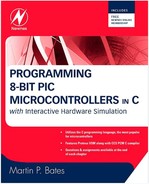Introduction
The book is organized in five parts. Part 1 includes an overview of the PIC microcontroller internal architecture, describing the features of the 16F877A specifically. This chip is often used as representative of the 16 series MCUs because it has a full range of peripheral interfaces. All 16 series chips have a common program execution core, with variation mainly in the size of program and data memory. During programming, certain operational features are configurable: type of clock circuit, watchdog timer enable, reset mechanisms, and so on. Internal features include the file register system, which contains the control registers and RAM block, and a nonvolatile EEPROM block. The parallel ports provide the default I/O for the MCU, but most pins have more than one function. Eight analog inputs and serial interfaces (UART, SPI, and I2C) are brought out to specific pins. The hardware features of all these are outlined, so that I/O programming can be more readily understood later on. The application development process is described, using only MPLAB IDE in this initial phase. A sample C program is edited, compiled, downloaded, and tested to demonstrate the basic process and the generated file set analyzed. The debugging features of MPLAB are also outlined: run, single step, breakpoints, watch windows, and so on. Disassembly of the object code allows the intermediate assembly language version of the C source program to be analyzed.
Part 2 introduces C programming, using the simplest possible programs. Input and output are dealt with immediately, since this is the key feature of embedded programs. Variables, conditional blocks (IF), looping (WHILE,FOR) are quickly introduced, with a complete example program. Variables and sequence control are considered in a little more detail and functions introduced. This leads on to library functions for operating timers and ports. The keypad and alphanumeric LCD are used in a simple calculator program. More data types (long integers, floating point numbers, arrays, etc.) follow as well as assembler directives and the purpose of the header file. Finally, insertion of assembler into C programs is outlined.
Part 3 focuses on programming input and output operations using the CCS C library functions. These simplify the programming process, with a small set of functions usually providing all the initialization and operating sequences required. Example programs for analog input and the use of interrupts and timers are developed and the serial port functions demonstrated in sample applications. The advantages of each type of serial bus are compared, and examples showing the connection of external serial EEPROM for data storage and a digital to analog converter output are provided. These applications can be tested in VSM, but this is not essential; use of VSM is optional throughout the book.
Part 4 focuses specifically on the PICDEM mechatronics board from Microchip. This has been selected as the main demonstration application, as it is relatively inexpensive and contains a range of features that allow the features of a typical mechatronics system to be examined: input sensors (temperature, light, and position) and output actuators (DC and stepper motor). These are tested individually then the requirements of a temperature controller outlined. Operation of the 3.5-digit seven-segment LCD is explained in detail, as this is not covered elsewhere. A simulation version of the board is provided to aid further application design and implementation.
Part 5 outlines some principles of software and hardware design and provides some further examples. A simple temperature controller provides an alternative design to that based on the mechatronics board, and a data logger design is based on another standard hardware system, which can be adapted to a range of applications—the BASE board. Again, a full-simulation version is provided for testing and further development work. This is followed by a section on operating systems, which compares three program design options: a polling loop, interrupt driven systems, and real-time operating systems. Consideration of criteria for the final selection of the MCU for a given application and some general design points follow.
Three appendices (A, B, and C) cover hardware design using ISIS schematic capture, software design using CCS C, and system testing using Proteus VSM. These topics are separated from the main body of the book as they are related more to specific products. Taken together, MPLAB, CCS C, and Proteus VSM constitute a complete learning/design package, but using them effectively requires careful study of product-specific tutorials. VSM, in particular, has comprehensive, well-designed help files; and it is therefore unnecessary to duplicate that material here. Furthermore, as with all good design tools, VSM evolves very quickly, so a detailed tutorial quickly becomes outdated.
Appendix D compares alternative compilers, and application development areas are identified that would suit each one. Appendix E provides a summary of CCS C syntax requirements, and Appendix F contains a list of the CCS C library functions provided with the compiler, organized in functional groups for ease of reference. These are intended to provide a convenient reference source when developing CCS C programs, in addition to the full CCS compiler reference manual.
Each part of the book is designed to be as self-contained as possible, so that parts can be skipped or studied in detail, depending on the reader's previous knowledge and interests. On the other hand, the entire book should provide a coherent narrative leading to a solid grounding in C programming for embedded systems in general.
